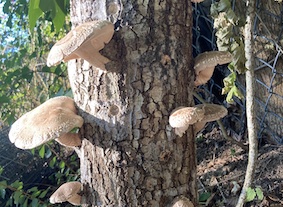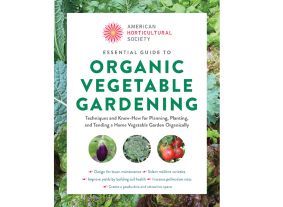DIY Shiitake Mushroom Logs—Harvest!
Views: 539

I dedicated four posts in early spring based on a do-it-yourself DIY log-grown mushroom class. This harvest-related update is built on upon those four posts:
Start: Phase 1, Substrate Acquisition
Did I Harvest?
Yes! Round about early June I noticed one small pancake-sized shiitake mushroom growing from my inoculated log. Its presence was a total surprise as my log hadn’t been inoculated for more than a few months. I had fully been expecting a harvest in fall, typically when I see edible mushrooms popping up in the woods around my home.
But, I don’t really consider this random single mushroom a “harvest.” It was a preview of what was to come.
Heat and Drought
The second half of July presented not only record days of heat, but also prolonged drought. In fact, the portion of Massachusetts where I live was officially labeled as being in “severe drought.” We had no appreciable rain for five or more weeks. I could have been longer—it certainly did feel longer!
You may or may not recall my mushroom class instructor advising to soak the inoculated logs when prolonged heat and dry weather occurred. Typically that means August in these parts, but 2022 brought those conditions about three weeks early.
Soaking the log was easy, once we found something to hold a large quantity of water. We had trashed our kiddie pool, and our wheelbarrow was way too short for the length of log. We ended up filling our fairly large beverage cooler with water and setting the log in diagonally. About two-thirds of the log could be submerged at a time. That’s okay, we just turned it the other direction after 24 hours. After that double dunking, we certainly had a moist log and wasn’t too worried about it drying out.
The Harvest Came Quickly
The instructor had mentioned the log is often triggered into production by the time it spending soaking. The thought of keeping an eye out for mushrooms on the log occurred to me about two days after the soak. And the next day, just three days after soaking, the log was already producing mushrooms.
I harvested about a half-pound of mushrooms approximately five days after pulling the log out of its bath. They were in all stages of development, really—from small ones the size of my ring finger to ones that were palm-sized. They had just a little bit of dirt on them, nothing much, so we brushed them off and placed them in a dry paper bag and popped them in the fridge. The next day we cooked them up and used most of them for a mushroom risotto, with extra to accompany an omelet the next morning. The flavor was superb, probably some of the best mushrooms we’ve ever had.
And here’s another surprise! About two weeks later I found another four mushrooms! Since I hadn’t been expecting them, they had gotten a bit old and crusty. No bother—I soaked those mushrooms in hot water to create a mushroom stock, and then sliced them into strips to roast and then include as a pizza topping. I froze that mushroom stock and when I make a mushroom soup later on, I’ll have all that extra flavor to add.
The instructor had mentioned commercial mushroom growers soak their logs every 6-8 weeks. If I don’t see mushrooms growing on their own in September I’ll get out the cooler again and give the log another soak. And as a reminder, I found an excellent video on how to go about harvesting your log-grown mushrooms.
Meet Ellen Wells
When you’re raised on a farm, you can’t help but know a thing or two about gardening. Ellen Wells is our expert on edible gardening.…
Ellen's Recent Posts

New Organic Vegetable Gardening Book








